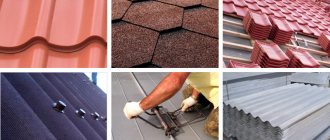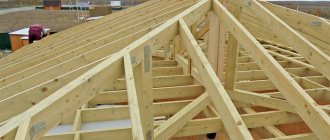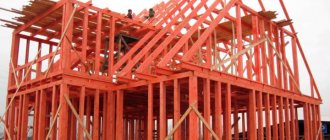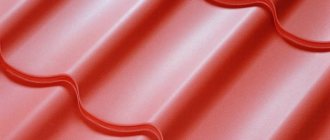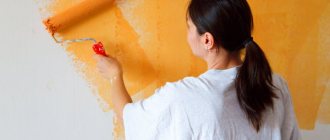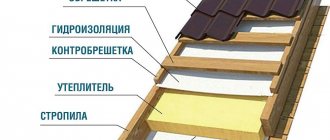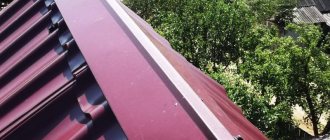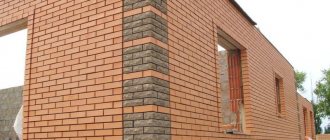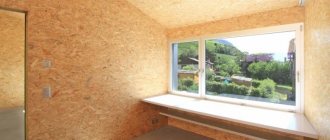Types of soft roofing
What types of flexible roofing are there? It is manufactured in two main types:
Roll
Soft roofing is supplied in rolls 10-20 m long and 90-110 cm wide. It is designed to cover long slopes, flat or with a minimal slope. The roll is rolled out on the roof into a sheet and glued to the prepared base using bitumen mastic.
Advantages:
- low price;
- high installation productivity.
Flaws:
- ineffective on roofs of small sizes and complex shapes;
- unaesthetic appearance;
- low resistance to mechanical damage.
Roll roofing is laid over a cement screed coated with a primer to improve adhesion. Before gluing, the cut strips must rest for at least a day to straighten.
Such materials are most often used for industrial or warehouse buildings of medium and large sizes. This is a good choice for a budget private house with a gable roof.
Bituminous shingles
This material is also called segmented soft roofing. During the production of their bituminized sheet, segments are cut out. During installation, they are glued to the base using mastic applied at the factory and secured with roofing nails.
The segments are laid overlapping in such a way that the locations of the nails of the bottom row are covered by the next row. At each point of the roof there are from 4 to 6 layers of roofing material.
Advantages:
- high reliability of the roof;
- excellent sound insulation;
- low percentage of waste when cutting on roofs of small area and complex shape;
- suitable for cone-shaped roofs.
Flaws:
- high price;
- high labor intensity of installation;
- Extreme care is required during installation.
Bituminous shingles are used to cover the roofs of private houses and public buildings with a slope of at least 12°. The variety of designs allows you to choose the right model for any style and size of the building.
Which soft roof is better? Each has its own scope of application.
Self-leveling roofing
Self-leveling roofing is a new method of waterproofing, which is used to construct flat roofs of multi-story residential, commercial and industrial buildings. It is a monolithic, seamless coating, which is obtained by pouring bitumen mastic. To strengthen the self-leveling roof, it is reinforced with a special mesh or fabric, and it can also be additionally thermally insulated. The following types of roofing mastics are distinguished:
- Hot. Hot mastic is called mastic, which must be heated to a temperature of 150-180 degrees before use. The mastic is heated in special containers, stirring continuously. If it boils over, the material will be damaged. Hot mastic is applied using a roller, brush, spray or pouring method, depending on the required layer thickness.
- Cold mastic. Cold mastic based on bitumen, moisture-resistant polymers, or even a mixture of them is produced in finished form. A thick, viscous, flowing liquid is poured into metal containers. There is no need to heat such mastic before installation, so working with it is much faster and easier. However, the price of cold self-leveling roofing is much higher.
Important! Mastic roofing is mainly used to cover flat roofs of multi-storey buildings, since it is not demanding on the angle of inclination of the slopes. Its main advantage is the absence of seams through which water can penetrate. If the installation technology is followed, the self-leveling coating will last more than 20 years.
Roofing mastics
Soft roof structure
A modern flexible roofing sheet is a complex multi-layer system.
Bitumen base
The supporting structure is a sheet of thick cardboard impregnated with bitumen or a sheet of fiberglass. It ensures the strength of the roofing material. Bitumen for impregnation is acidic or alkaline.
Sprinkles
A layer of mineral chips with the addition of a coloring pigment protects soft cardboard from mechanical damage. Coarse-grained topping traps snow and complicates its natural descent from the slope.
The best manufacturers of soft tiles use basalt chips without impurities; in budget lines, cost-reducing additives can be added to basalt.
Base: fiberglass or cardboard? What's better?
Initially, cardboard was used as a base for soft tiles. It is affordable but has limited durability. In modern models of flexible tiles, fiberglass is increasingly used.
This material is better in quality and several times more durable than cardboard. In addition, it has an almost significantly lower specific gravity with equal strength. This allows you to reduce the load on the rafter system.
Fiberglass fabric is not subject to corrosion and age-related changes in the structure; the increased service life fully justifies the high price of the material.
Roll roofing: a simple solution
If you are looking for a fairly simple and reliable solution for your roof, then pay attention to rolled materials for soft roofing, which have been tested for decades.
The main ingredient of popular rolled roofing felt materials is bitumen. Bitumen for the roof is primarily good because it does not support the combustion process. Secondly, it has high heat-saving and noise-insulating qualities, which is valuable for attic spaces. And thirdly, it perfectly withstands any atmospheric and temperature influences, and therefore, as a material for roofing, it is practically irreplaceable.
Roll materials are good for roofs that have a slight slope. Their main advantage is their low cost, light weight, ease of installation and absolute corrosion resistance. The disadvantages are fire resistance and periodic repairs that are necessary.
Roofing carpet is rolls that need to be rolled out in two layers. The top one can additionally be coated with a special protective coating.
The following types of materials are used as a roll roof:
- Basic and non-basic with the structure of the canvas.
- Polymer, bitumen and bitumen-polymer.
- Asbestos, cardboard, fiberglass and combined.
- With foil, film, dust, flakes, coarse-grained and fine-grained toppings.
According to the installation method, roll roofing is divided into traditional ones, such as roofing felt and glassine, and more modern ones, which are literally melted with the help of fire and glued to the base. This type of roofing is also called “floated roofing”. You can handle the installation of such a roof yourself if you get hold of professional equipment and learn a little:
Why bother with such complex technology? There is one significant plus in a built-up roof, which overshadows all the minuses - absolute, 100% final tightness.
Have you decided on a rolled soft roof? Then learn to understand its quality before purchasing. Thus, bituminous materials are produced oxidized and non-oxidized. What is the difference, because you will probably come across such concepts when choosing a roll roofing? The fact is that ordinary bitumen softens under the scorching sun already at a temperature of 45-50°C. You don't want hot streams of resin forming on your roof on a regular July day, do you? This is the purpose for which another type of material is produced - oxidized bitumen, which tolerates heat remarkably well, but loses its frost resistance.
It turns out that the first type of materials is more appropriate for the southern regions of the country, and the second for the northern regions. When calculating what you will need for your home in the middle zone, just find out the average temperature in summer and winter and decide what is more important to you - resistance to temperature deformations and or frost. It is important!
By the way, polymer-bitumen roofing is a combined material that has a much wider range of operating temperatures. But its price, of course, is much higher. So choose!
Advantages of a soft roof
Soft roofing has a number of obvious advantages over other types of roofing materials, such as metal tiles, seam roofing, ondulin or ceramics. These include:
- Wide choice of shapes and shades, aesthetic appearance.
- Affordable price.
- Long service life. The material is not subject to rust and rotting.
- High tightness.
- Elasticity makes it possible to use complex shapes on roofs, including curved, conical and domed. No other material is suitable for this.
- Low percentage of waste when cutting;
- Resistance to ultraviolet radiation, temperature and humidity changes.
- Excellent sound insulation and thermal insulation properties. For a private house, the roof becomes an additional layer of insulation. The sound of rain is practically inaudible even in gazebos and open verandas.
- Installation is quite simple and can be done independently
The material also has a number of disadvantages:
- Not applicable on slopes with a slope of less than 12°.
- A continuous is required .
- It is necessary to install ventilation ducts to protect the rafter system from high humidity.
- High surface roughness . This leads to the accumulation of dust and small debris. Moss may grow in shady areas. In winter, the roughness prevents the natural melting of snow.
- High requirements for installation accuracy . Only correct and careful installation will ensure high quality coating and aesthetic appearance.
The advantages of a flexible roof significantly outweigh its disadvantages. More and more homeowners are choosing inexpensive and easy-to-use material.
Installation method
Most of the materials for roll roofing are fused to the base. For this purpose, special burners are used, connected to liquefied gas cylinders. With their help, the bottom layer of binder melts, adhering to the base or already laid material. This technology is used on flat roofs covered with reinforced concrete slabs (for example, on garages).
Method of installing roll roofing on mastic
In private housing construction, flat roofs are very rare in our country. On small houses this is usually a gable roof, less often - a single-pitch roof. The rafter system and sheathing of these roofs are wooden, the use of open fire on them is a big risk, and owners of dachas or small houses are looking for rolled roofing that does not need to be fused. There are such materials. Some of them are attached with mastic, some are nailed (more on them below). There are materials with a self-adhesive layer. All you need to do is remove the protective film, roll out the material and press it tightly.
Roll roofing made of material with a self-adhesive layer
Features of flexible tiles
When choosing a roofing material, you should consider the following features of flexible tiles:
- Base material . Affects the strength and durability of the coating. If funds allow, it is better to stick with fiberglass canvas.
- Type of bitumen impregnation . Modified SBS bitumen is the best impregnating material today.
- Type of sprinkling . Basalt chips create the most durable and durable coating layer. It does not glare in the sun, creating the “cheap roof effect”.
- Bituminous mastic applied to the underside of the segments loses its adhesive properties over time and adheres less well to the base. Therefore, it is better to install soft tiles no later than six months from the date of production.
Types of protective coating
Binders that are used in the production of rolled roofing materials require protection from weather conditions. Sprinkles of varying degrees of grinding are used as a protective layer:
- coarse-grained (K);
- fine-grained (M);
- dusty (P);
- scaly (H);
- special resistant to alkalis or acids.
Coarse-grained topping not only protects, but also gives a decorative appearance.
In the marking, the letter indicating the type of sprinkle is placed third. Rolled materials used for lining are sprinkled on both sides with fine-grained or dusty powder. Its task is to prevent the roll from sticking together.
Fine-grained or dust-like crumbs are also applied to the back side of the roofing roll material, and coarse-grained or scaly crumbs are applied to the front side, which not only protects the coating, but also gives it a more attractive appearance. To give it an even more aesthetic appearance, the sprinkles are painted in different colors. Typically the colors are red, grey, burgundy, brown, green and blue.
Installation features
Installation of flexible tiles does not require special qualifications of workers or the use of expensive equipment. It is better to choose a hot sunny day for installation. High air temperature will further soften the mastic and improve adherence to the base, especially on roofs of complex shape.
For a soft roof, a continuous sheathing will be required. If necessary, the surface is leveled with sheets of OSB or plywood. Next, an underlay carpet is laid, it is fixed with roofing nails, and the joints are sealed with mastic.
The laying of segments begins with the cornice elements. The lower part is glued to a layer of mastic applied to the reverse side, and the upper part is nailed. Each subsequent layer of segments is shifted laterally by half an element. Ridge elements, places where they join other slopes, walls, pipes, etc. coated with bitumen mastic.
Types of binder
The base of the rolled roofing material is coated on both sides with a binder protective composition. It could be:
- bitumen (Gidroizol based on asbestos paper, glass rubber);
- tar, bitumen-tar compositions;
- rubber-bitumen composition (Stekloizol)
- rubber-polymer;
- polymeric.
The best characteristics are found in rubber-bitumen and polymer-bitumen compounds. Some of them are designed for use in severe frosts - down to -40°C, while others tolerate high temperatures - up to +150°C.
Folgoizol - foil is glued to the bitumen-polymer binder on one side
For regions with high temperatures, there are roll roofing materials based on foil - Folgoizol. Bitumen-rubber or bitumen-polymer binder is applied to the foil from the bottom side. Due to the reflective properties of the foil, the roof temperature will be 20°C lower. The front surface can be painted with weather-resistant paints and varnishes. Folgoizol bends well, is cut, and nailed with roofing nails. There are roofing (FC) and waterproofing (FG).
Comparison of manufacturers
How to choose the right manufacturer?
Foreign brands are traditionally famous for their high quality and wide selection of shapes and colors. The price is also high. It is justified by the long service life of the coating and the absence of the need for work to replace it.
Which companies are the most popular? The leaders of the ratings are often:
- Finnish Katepal . Traditional Finnish quality and excellent soundproofing properties.
- German Doсke . The budget line has a 20-year warranty. The premium line offers a 50-year warranty.
- Italian Tegola . The widest selection of shapes, patterns and palettes. Production is localized in Russia.
Among local manufacturers, we can note the Shinglas trademark of the TechnoNIKOL company. It produces a wide range of roofing materials based on fiberglass. Single-layer models are quite affordable in price, and even top-end two-layer models continue to be affordable.
Soft tiles
Available in the form of small tiles - shingles . It is easy to install, which allows you to install the roof even with your own hands. The technical characteristics and features of soft tiles include:
- sizes from 1 x 0.33 m;
- length – 60 m or more;
- density – from 8.5 to 11.5 kg/m2;
- roof inclination angle – from 12 degrees;
- variety of shapes , sizes and colors;
- the weight of a soft roof per 1 m2 with a thickness of 3 mm is 1.3-5.5 kg;
- non-susceptibility to corrosion processes and rotting;
- the width and thickness of the membranes are 0.9-15 m and 0.8-2 mm, respectively;
- low thermal conductivity and high sound insulation properties;
- stylish appearance, visually indistinguishable from natural tiles.
Soft tiles
Comparison of manufacturers' pricing policies
What price should tiles have? Most manufacturers have a flexible pricing policy. They produce budget lines with a cost per square meter of 250-350 rubles.
For consumers with higher needs for reliability and durability of the roof, premium product lines are offered in the range of 700-1300 rubles/m2. The most expensive models can reach 3,500 rubles/m2.
Often both lines have a similar set of shapes and range of shades. This allows you to cover the main building on the site with high-quality flexible tiles, and auxiliary buildings and gazebos with simpler material, maintaining a single stylistic solution.
In this way, manufacturers are trying to expand their market coverage.
Soft tile roofing technology
Elastic coating is easy to cut and install, but requires compliance with certain features. So, it is necessary to equip it with a continuous sheathing.
Installation of soft tiles (photo No. 2)
The step-by-step technology for arranging a roof can be presented as follows:
- ➠Installation of sheathing
- ➠Laying under-roof carpet
- ➠Installation of gable and cornice strips
- ➠Installation of tile shingles
- ➠Completing work (arranging holes in the roof for antennas, chimneys and communications).
Depending on the configuration, size and complexity of the roof, the technology may differ slightly. Next we will look at an average option that is suitable for most simple roofs.
Step 1. Installing the sheathing
Flexible roofing material repeats all the flaws and unevenness of the surface on which it is installed. This means that to install a roof under soft tiles, you need to install a continuous sheathing made of even, smooth materials. Will fit
- OSB-3 boards;
- sheet moisture-resistant plywood FSF;
- boards (cut or tongue-and-groove; for example, from softwood with a moisture content of about 20%).
!
Note!
The continuous lathing is laid out in a checkerboard pattern, leaving a compensation gap of 3-5 mm between the panels for thermal expansion of the material.
First, a sheathing of edged boards is installed on the rafters parallel to the roof slope. The distance between them is selected according to the dimensions of the sheet sheathing. Each panel should lie on three boards: 2 at the edges and one in the middle.
Continuous sheathing for soft tiles (photo No. 3)
Solid sheathing slabs are laid offset to give the structure more strength. A compensation gap (3-5 mm) is left between them to ensure free expansion of materials when heated during the summer sun.
Step 2. Installation of drip line (eaves strip)
Installing the cornice strip (photo No. 4)
A drip edge is a metal strip that is mounted on the eaves overhang to mechanically strengthen it and protect the wooden elements of the roof from rain and melt water. Thanks to the drip, water from the roof will flow into the drainage system installed under the eaves.
Structurally, a drip edge is a corner with a shelf width of 15 to 25 cm and a length of about 3 m. They are attached with an overlap using roofing nails, which are driven in a zigzag pattern. The distance between the fasteners should be 15 cm.
Step 3. Installation of underlay carpet
The finished sheathing is covered with a lining (under-roofing) carpet made of bitumen-polymer material.
Laying the under-roof carpet (photo No. 5)
What is it for? Level the surface of the sheathing before laying shingles, improve the waterproofing properties of the roofing “pie” and extend its service life.
The underlayment carpet must correspond in physical and operational characteristics to the selected bituminous shingles. After all, if its service life is shorter, the roof will have to be replaced prematurely.
How to install underlay carpet?
!
Note!
Installation of the underlayment begins with the valley, then covers the slopes and the entire surface of the roof.
The rows of the carpet are overlapped by 10 cm in length and by 15 cm in width. They start from the valley. The bitumen-polymer carpet is laid on it so that the middle of the valley coincides with the middle of the carpet, and there is at least 50 cm of coverage on each side.
On overhangs, the carpet is laid along the cornices, covering half the drip shelf. After this, the entire surface of the roof is covered. This is done from the bottom up, covering the previous row by 10 cm. If you need to combine two fragments of carpet in one row, the ends of the lower one overlap the upper one by 15 cm, having previously lubricated it with bitumen mastic.
If there are a lot of decorative features on the roof, it may be more convenient to lay the underlayment horizontally. Then the installation begins from the lower left edge of the slope.
The carpet is secured along its entire length with roofing nails or self-tapping screws.
Step 4. Construction of the pediment and roof overhang made of soft tiles
Pediment and cornice strips (photo No. 6)
To install the pediment and roof overhang, a pediment strip is used, which strengthens and protects the end sections of the sheathing from moisture. It is mounted in the same way as a cornice: the planks are overlapped and secured with nails in a zigzag manner in increments of 15 cm.
Step 5. Installation of the valley carpet
Installation of valley carpet (photo No. 7)
The roof valley experiences the highest loads during rain and snowfall. Therefore, it needs to be further strengthened and insulated.
Using bitumen mastic, a valley carpet is glued to the roofing carpet on the valley. This is a rubber-bitumen coating stitched with polyester mesh.
Along the perimeter, retreating 3 cm from the edge, the carpet is nailed in increments of 20-25 cm.
It is important to choose the right color for the valley carpet so that it matches the tiles. As a rule, materials of the same shade are chosen, less often - contrasting ones.
!
Note!
The bottom of the valley is not covered with tiles - the valley carpet will be visible there.
Therefore, you need to choose it in such a way that it matches the color with the rest of the roof. If desired, instead of a valley carpet, you can use a metal valley.
Step 6. Installation of tiles
Installation of soft tiles (photo No. 8)
Installation of shingles begins from the starting row. You can make it yourself by cutting off the petals of the shingles. Or purchase ready-made starter strips - they are called ridge-eaves tiles.
You can start laying from the middle of the row or from the edge, but definitely along the eaves, at a distance of 1.5-2 cm from the overhang. Along the perimeter, the ridge-eaves tiles are nailed with roofing nails, at a distance of 20 cm from each other.
Each next row of shingles is placed offset so that they cover the attachment points of the previous one with their petals. Nailed with roofing nails. If the slope angle is less than 45 degrees, the shingles are secured with 4 nails. If more than 45 degrees - 6 nails.
Step 7: Installing Shingles Around the Valley
There is often a lot of water in the valley, so holes should not be made in this area.
What should I do? From the center of the valley 30 cm in each direction, the shingles are not nailed, but glued with bitumen mastic. The bottom of the valley 5-15 cm wide is left without tiles.
Step 8: Skate Equipment
Row by row we get closer to the ridge.
The construction of a skate using a special metal element. (photo No. 9)
You need to leave a distance of about 2-3 cm between the slopes to ensure the escape of air and moisture from under the roof. A special metal ridge element is mounted on top. It is secured with self-tapping screws.
You can decorate the ridge in another way. For example, using a homemade ridge element, which is covered with bitumen shingles. It is also possible to make a solid roof with special ventilation hoods
The roof, covered with soft tiles, is ready.
Conclusions: which flexible tile to choose
How to choose flexible tiles? When choosing soft tiles for the roof of a house, you need to proceed from the purpose of the building.
For a residential building, it is better not to save money and purchase high-quality and wear-resistant tiles from the best manufacturers with a long service life. This will ultimately allow you to save on dismantling the roof that has become unusable and installing a new one.
For canopies, gazebos and auxiliary unheated buildings, you can choose a flexible roof of the same color and pattern from the same manufacturer from the budget line.
Features of a soft roof
Soft tiles for roofs with a large slope are more profitable than other materials. Possessing natural tenacity, it can be laid on roofs at an angle of 90°. There are no complex roof configurations for bitumen material. Bitumen sheets can be laid on complex curved surfaces with high precision joining and fit. Such material cannot replace any other product in this regard.
Due to its flexibility, soft roofing easily bends around the corners of the roof.
